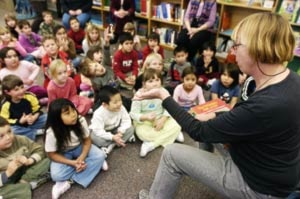Jan Thornhill had skulls in her handbag.
There are insects in there too, said the children’s author, pointing at her bulging, black bag.
A chorus of “eeeeewwws” filled the Takhini Elementary School library.
She’d got their attention.
The Grade 1s, 2s and 3s sat on the floor expectantly.
“A is for auk, who lives by the sea. B is for beaver, felling a tree.”
The kids had never heard of auk, but they’d all seen beavers.
Auks were like big northern penguins, said Thornhill.
They couldn’t fly, and the early explorers used to hit them over the head with sticks and then eat them, she said.
The kids laughed.
When museums realized they were disappearing, they all wanted to have a stuffed auk for their collection.
“The last auk was killed for a museum over 100 years ago,” she said.
“Do you know what we call that?”
“Extinct,” chimed a bunch of kids.
Thornhill pulled out another book.
“This one has a lot of writing in it,” she said, holding up a thin book about the 212-year life of a maple tree.
A lot of the kids had already read it.
“I illustrate my own books,” Thornhill told the kids.
“I’ve been drawing all my life, but it did something to my wrist — now it hurts.”
Thornhill turned to technology for help.
“Have you ever heard of Kids Pics?” she asked.
“Yeeess,” yelled the kids.
It’s a computer program that allows images to be scanned and turned into stamps.
Thornhill painted leaves, flowers, trunks and branches, scanned them, and built her own trees with the computer stamps.
Then she painted animals — hares, boars, zebras, deer and lions — and did the same thing.
Look how many animals are on this page, said Thornhill, holding open an East Indian story she’d written and illustrated.
There are 853 animals on these two pages, she said.
So, the stamps came in handy.
The story was about a green-eyed hare that heard a mango drop behind her and thought the world was breaking up.
As she runs, she relays the calamity to various herds of Indian animals, which join her.
The kids were sitting quietly, but they were starting to fidget.
After all, there hadn’t been any mention of skulls or bugs for a while.
Then Thornhill pulled out her most recent book.
It’s called I Found a Dead Bird, The Kids Guide to the Cycle of Life and Death.
“When I was a kid, I was interested in dead things,” said Thornhill.
“I remember turning over a dead squirrel with a stick to see what was going on underneath it.”
There was another congratulatory “eeeeewww,” from the audience.
“Do you know what would happen if there wasn’t any death?” she asked the kids.
“What if flies didn’t die?”
Their offspring would breed, and these offspring would breed and so on, and in four months an area as big as the Amazon rainforest would be waist deep in flies, she said.
“Eeeeeewwwww.”
“How do flies die?” she asked.
“You kill it with a stick,” yelled a little boy.
“Hit it with a baseball bat,” said another.
“It gets caught in a Venus flytrap,” called a girl from the back.
The young learners were interested in death.
“When I was thinking about writing this book, I went on Amazon.com to see how many other kids books on death were out there,” said Thornhill, after the reading.
“And there was nothing like it.”
It’s usually a very tight market, she said.
“People are publishing way too many kids books.
“But as long as they keep publishing mine… ” she said with a laugh.
After discussing the demise of flies with the students, Thornhill started taking little bottles and tiny plastic cases out of her bag.
The first thing she pulled out was a pair of preying mantises.
“The female eats the male while mating,” said a little girl.
There were cicadas, a crow skull, two dead hummingbirds, a deer skull with a moving jaw, a dinosaur bone, a mummified bat she found in her furnace in the fall.
She also displayed some snakeskin, a wolf’s tooth, a baby porcupine skull, a whale’s rib from Newfoundland and many other treasures.
Thornhill took a minute to talk about each item, explaining the creature’s life cycle, or how she’d found the sample.
The kids leaned forward, craned their necks and edged closer and closer as she talked.
“These have gone through the hands of more than 10,000 kids across the country,” she said, noting that the arctic fox skull was missing its canines.
“They’re getting kind of wrecked — but not by kids. It’s the baggage handlers on the airplanes,” she said.
Then, it was the moment all the kids were waiting for — Thornhill passed out the insects, bones and skulls.
“Can I have the snakeskin,” said one little boy, hopping up and down on his bum.
The dead hummingbirds were a hit.
“Look at the colour on its throat,” said a little boy, holding up the jar.
The hour was up, but the kids didn’t want to leave.
“Can I keep this jar,” said a little boy earnestly.
Thornhill gently shook her head.
“Then there wouldn’t be any samples left for other kids to look at,” she said.
The little boy nodded gravely.
He understood.
Thornhill will be sharing her treasures with kids in Haines Junction on Thursday at St. Elias School, and will be visiting Whitehorse’s Jack Hulland School Friday.
There’s a book signing at Mac’s Fireweed Books on Saturday, from 1 to 2 p.m.
Wednesday evening she’ll conduct an adult writing workshop at the Whitehorse Public Library from 6:30 to 8:30 p.m.
